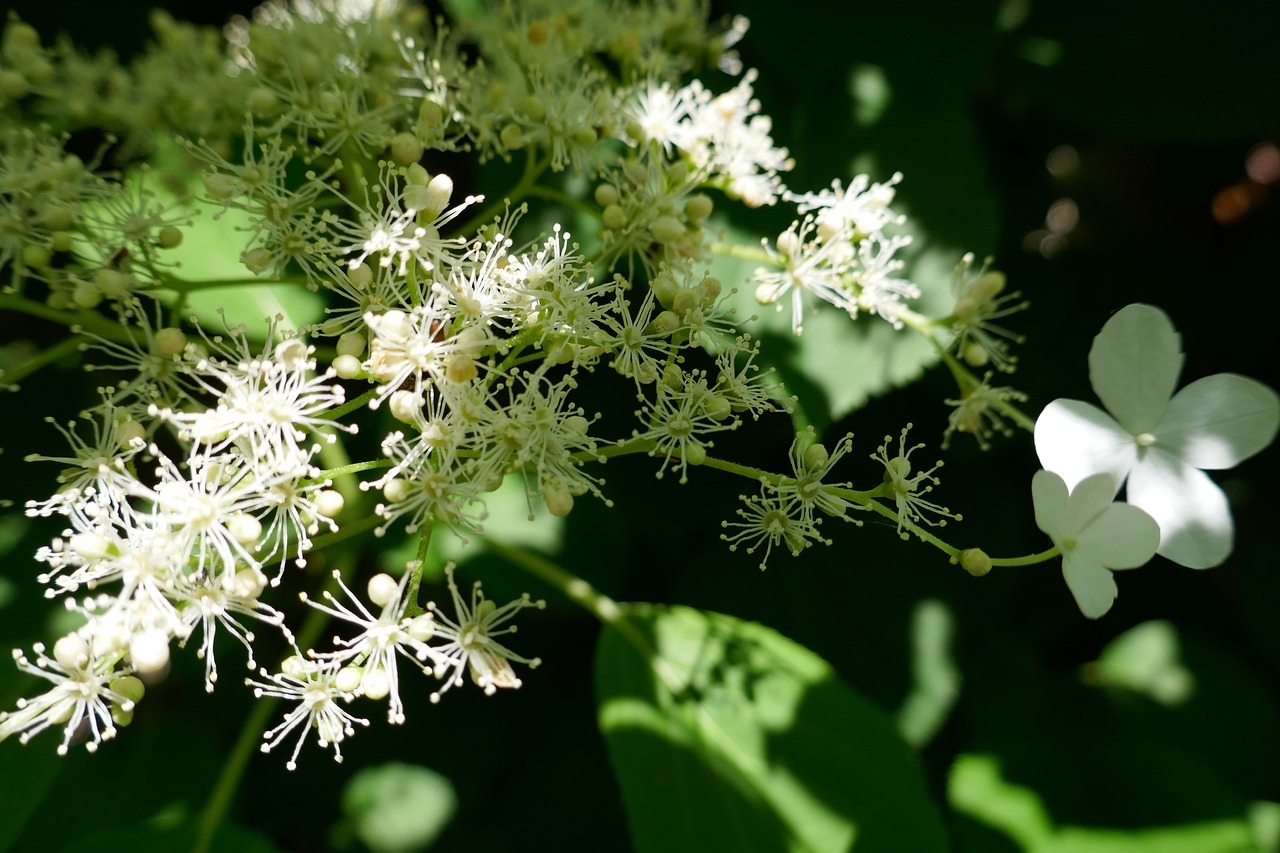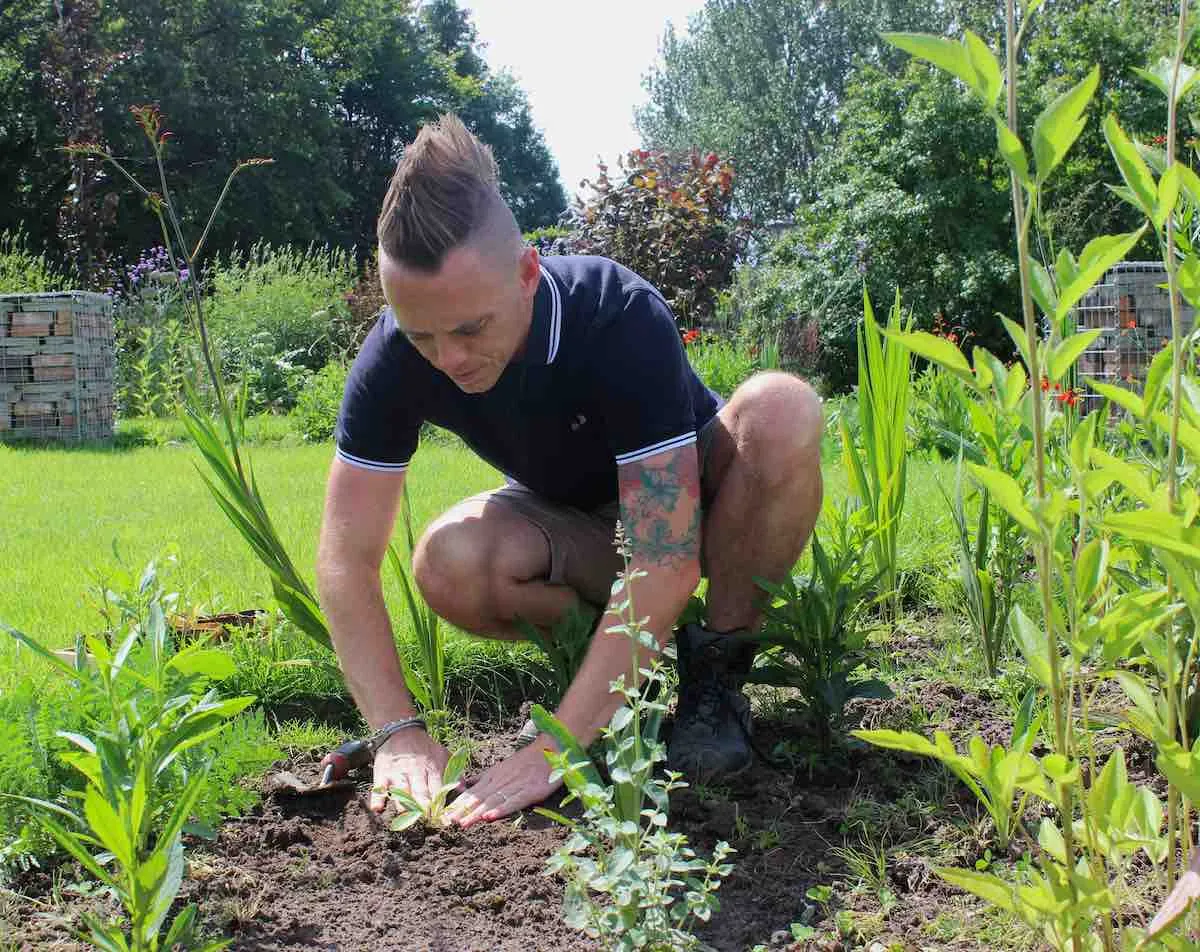Hi @claireloui79
Thanks ofor submitting your gardening question about what climbing plant to use on your wall to grow up[ and through the Cherry laurel.
One of the best climbers for a north facing garden is the climbing Hydrangea. Hydrangea petiolaris self-clings to walls and fences, meaning you don't need to attach wires.

Benefits of Hydrangea petiolaris
Think of Hydrangea petiolaris as the botanical equivalent of an old stately manor covered in ivy — but better behaved, longer-flowering, and far less likely to trash your brickwork. It's a deciduous, self-clinging climbing hydrangea that's perfect for adding drama to walls, fences, and even tree trunks in tricky shaded areas.
Thrives in Shade
This is the holy grail for awkward, north-facing or shaded spaces where nothing else seems to thrive. Hydrangea petiolaris loves partial to full shade. Total goth vibes.
Low Maintenance, High Drama
Once established, this climber pretty much takes care of itself. Just some light pruning if it gets a bit wild. Ideal for lazy gardeners or those juggling a million projects.
Spectacular Summer Flowers
From late spring to early summer, expect a glorious display of flat, lacy, creamy-white blooms up to 25cm across. They contrast beautifully with the deep green foliage.
Self-Clinging (No Wires Needed)
Thanks to aerial roots, it sticks to walls and fences without any input from you! No trellis, wires or support systems required – it's climbing with punk attitude.
Wildlife Friendly
Pollinators adore it, especially bees. Those dinner plate-sized flowers are nectar-rich banquets. You're helping biodiversity with this plant species.
Beautiful Autumn Foliage
Come autumn, the leaves turn a buttery yellow – like Mother Nature’s final mic drop before winter.
Growing Conditions for Hydrangea petiolaris
Light:
Hydrangea petiolaris loves the shade. It's one of the few climbers that actually prefers it. Partial shade to full shade is ideal — a north or east-facing wall is its comfort zone. It can tolerate a touch of morning sun, but harsh afternoon rays can scorch its foliage, so keep it cool and sheltered.
Soil:
This climber isn’t too picky, but give it moist, well-drained soil for best results. Slightly acidic to neutral pH is perfect — think rich, crumbly, woodland-style soil. It doesn’t enjoy soggy feet or bone-dry dust bowls, so if you’ve got heavy clay, work in some organic matter to improve drainage.
Watering:
Keep it well watered in the first year while it’s establishing its roots. Once it’s settled in, it becomes surprisingly drought tolerant. That said, during prolonged dry spells or heatwaves, it’ll still appreciate a top-up — especially if it's growing against a wall where soil dries out faster.
Support:
This plant is a self-clinger thanks to its aerial roots, so it’ll happily scramble up rough brick, stone walls, or even tree trunks without any help. If you're planting it against a smooth wall (like painted render), it might need a bit of support or a wire mesh to get going until it latches on.
Position:
Choose a sheltered, shady spot. A north-facing wall is classic, but it also does brilliantly climbing up mature trees in a woodland garden. Avoid super exposed positions where cold winds could strip its early buds or flowers.
Pruning:
Minimal effort required here. Prune after flowering if you want to keep it in check or remove dead, damaged, or straggly stems. But in general? Let it do its thing. It looks best when it’s left to grow naturally.
Hardiness:
Fully hardy across the UK — from the winds of the northwest to the chillier eastern counties. It can take a proper frost and bounce back stronger than ever.
How to Grow Hydrangea petorialis
-
Patience is key. It’s slow to establish (first 2–3 years = sulky teen phase), but once it’s happy, it grows vigorously.
-
Mulch, mulch, mulch. In spring, a good layer of organic mulch will keep roots cool and moist, especially if you’ve got dry shade.
-
Don’t move it. Climbing Hydrangeas hate being transplanted once they’re settled in.
-
Pair with ferns or hostas beneath for a lush, layered look that thrives in shade.
-
Avoid painting your wall once it’s growing. Those roots don’t like being yanked about.
Shaded Climber Perfect For:
I hope that helps Claire and do share some pictures with us here at Garden Ninja!
All the best
Lee Garden Ninja
Hi @claireloui79
Thanks ofor submitting your gardening question about what climbing plant to use on your wall to grow up[ and through the Cherry laurel.
One of the best climbers for a north facing garden is the climbing Hydrangea. Hydrangea petiolaris self-clings to walls and fences, meaning you don't need to attach wires.

Benefits of Hydrangea petiolaris
Think of Hydrangea petiolaris as the botanical equivalent of an old stately manor covered in ivy — but better behaved, longer-flowering, and far less likely to trash your brickwork. It's a deciduous, self-clinging climbing hydrangea that's perfect for adding drama to walls, fences, and even tree trunks in tricky shaded areas.
Thrives in Shade
This is the holy grail for awkward, north-facing or shaded spaces where nothing else seems to thrive. Hydrangea petiolaris loves partial to full shade. Total goth vibes.
Low Maintenance, High Drama
Once established, this climber pretty much takes care of itself. Just some light pruning if it gets a bit wild. Ideal for lazy gardeners or those juggling a million projects.
Spectacular Summer Flowers
From late spring to early summer, expect a glorious display of flat, lacy, creamy-white blooms up to 25cm across. They contrast beautifully with the deep green foliage.
Self-Clinging (No Wires Needed)
Thanks to aerial roots, it sticks to walls and fences without any input from you! No trellis, wires or support systems required – it's climbing with punk attitude.
Wildlife Friendly
Pollinators adore it, especially bees. Those dinner plate-sized flowers are nectar-rich banquets. You're helping biodiversity with this plant species.
Beautiful Autumn Foliage
Come autumn, the leaves turn a buttery yellow – like Mother Nature’s final mic drop before winter.
Growing Conditions for Hydrangea petiolaris
Light:
Hydrangea petiolaris loves the shade. It's one of the few climbers that actually prefers it. Partial shade to full shade is ideal — a north or east-facing wall is its comfort zone. It can tolerate a touch of morning sun, but harsh afternoon rays can scorch its foliage, so keep it cool and sheltered.
Soil:
This climber isn’t too picky, but give it moist, well-drained soil for best results. Slightly acidic to neutral pH is perfect — think rich, crumbly, woodland-style soil. It doesn’t enjoy soggy feet or bone-dry dust bowls, so if you’ve got heavy clay, work in some organic matter to improve drainage.
Watering:
Keep it well watered in the first year while it’s establishing its roots. Once it’s settled in, it becomes surprisingly drought tolerant. That said, during prolonged dry spells or heatwaves, it’ll still appreciate a top-up — especially if it's growing against a wall where soil dries out faster.
Support:
This plant is a self-clinger thanks to its aerial roots, so it’ll happily scramble up rough brick, stone walls, or even tree trunks without any help. If you're planting it against a smooth wall (like painted render), it might need a bit of support or a wire mesh to get going until it latches on.
Position:
Choose a sheltered, shady spot. A north-facing wall is classic, but it also does brilliantly climbing up mature trees in a woodland garden. Avoid super exposed positions where cold winds could strip its early buds or flowers.
Pruning:
Minimal effort required here. Prune after flowering if you want to keep it in check or remove dead, damaged, or straggly stems. But in general? Let it do its thing. It looks best when it’s left to grow naturally.
Hardiness:
Fully hardy across the UK — from the winds of the northwest to the chillier eastern counties. It can take a proper frost and bounce back stronger than ever.
How to Grow Hydrangea petorialis
-
Patience is key. It’s slow to establish (first 2–3 years = sulky teen phase), but once it’s happy, it grows vigorously.
-
Mulch, mulch, mulch. In spring, a good layer of organic mulch will keep roots cool and moist, especially if you’ve got dry shade.
-
Don’t move it. Climbing Hydrangeas hate being transplanted once they’re settled in.
-
Pair with ferns or hostas beneath for a lush, layered look that thrives in shade.
-
Avoid painting your wall once it’s growing. Those roots don’t like being yanked about.
Shaded Climber Perfect For:
I hope that helps Claire and do share some pictures with us here at Garden Ninja!
All the best
Lee Garden Ninja
claireloui79 has reacted to this post.
 Lee Burkhill: Award Winning Designer & BBC 1's Garden Rescue Presenters Official Blog
Lee Burkhill: Award Winning Designer & BBC 1's Garden Rescue Presenters Official Blog



